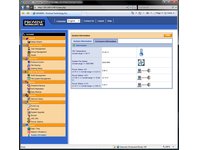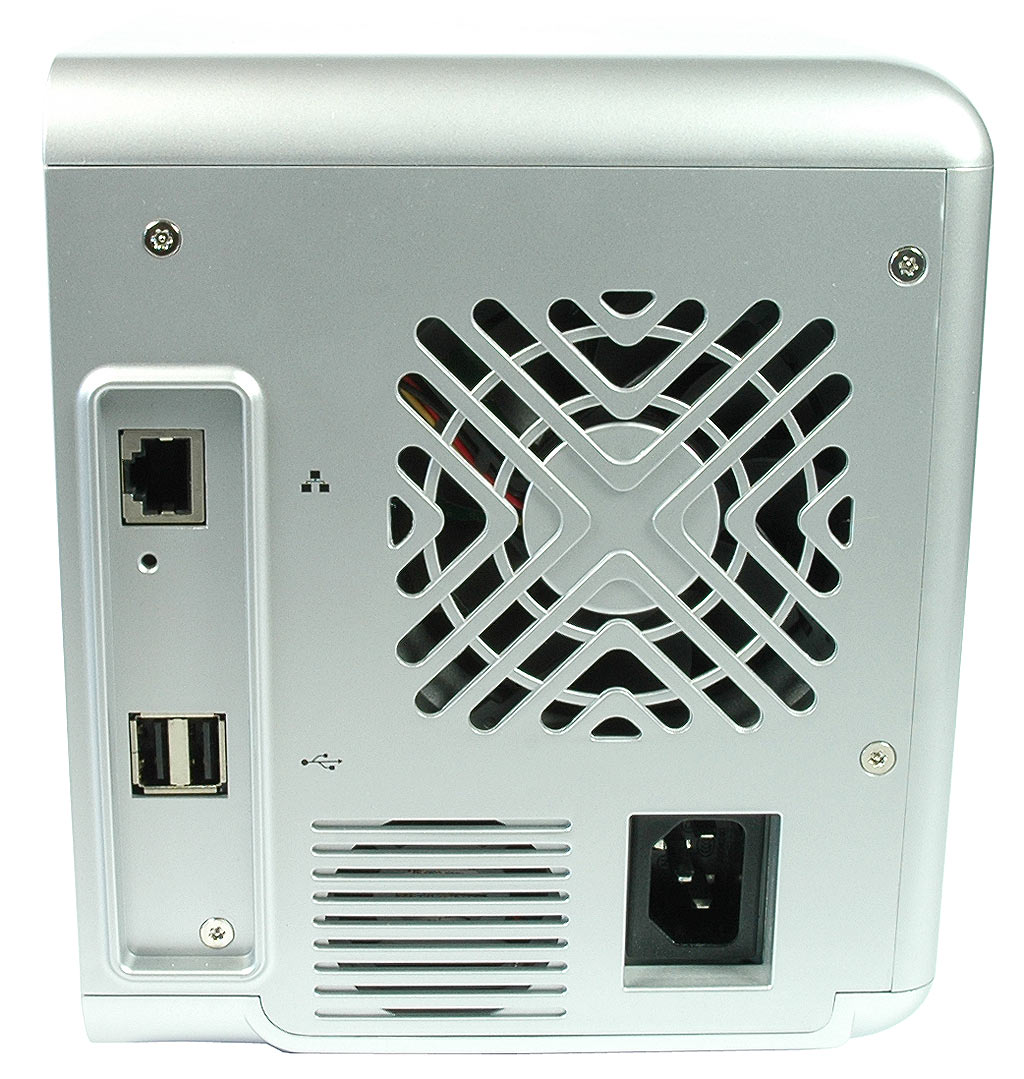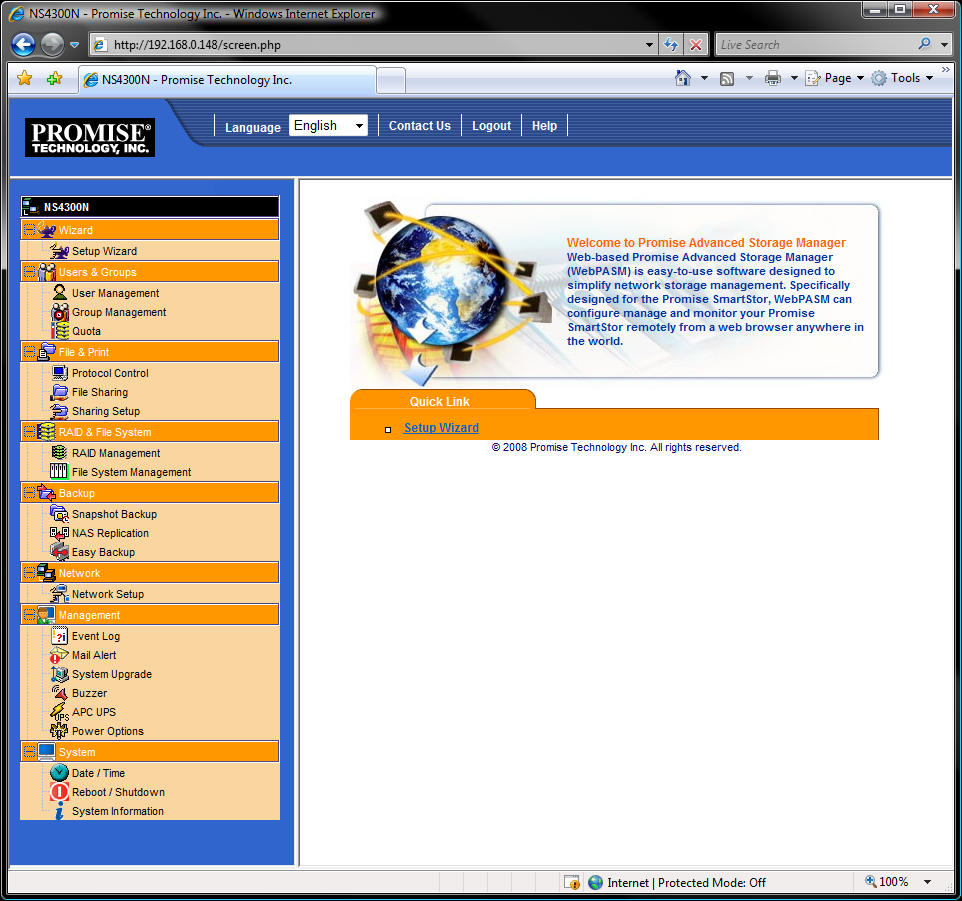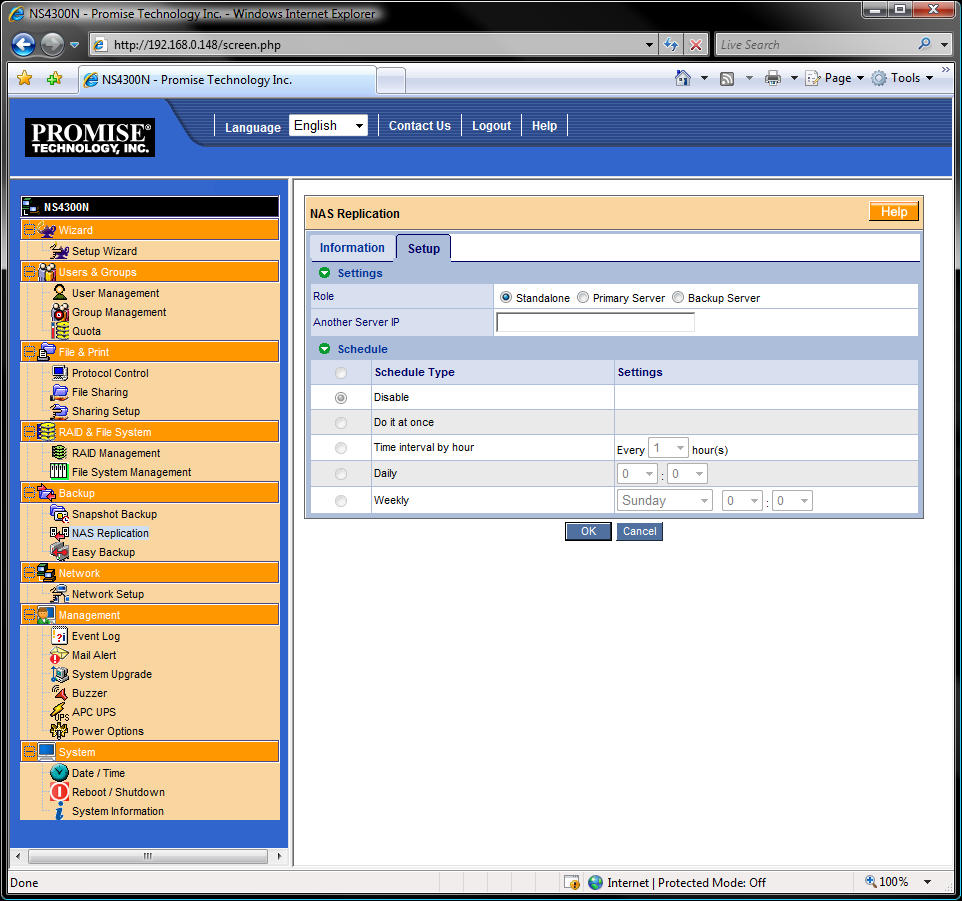Promise NS4300N: NAS For Small Offices
Technical Data And Features
The Promise NS4300N has dimensions of 19 cm (height) x 15 cm (width) x 23 cm (length); its weight without drives is just 2.5 kg. The rear of the NAS unit is clearly laid out and has a Gigabit Ethernet port and also two USB ports. These can be used to connect additional drives such as an external hard drive or thumb drive. The NAS unit also supports a USB printer and the connection of an uninterruptible power supply (UPS) via USB. For the NAS unit to be able to access external drives, these must be formatted using the FAT32 or EXT3 file systems.
Noisy Fan
Because the NS4300N has an internal power supply, the rear of the unit also has air outlets for the drives as well as for the power supply fan. The volume of the drive fan is unpleasantly loud—it runs at around 3,000 RPM and this speed is not regulated in accordance with the ambient temperature, which we found unacceptable.
When asked, Promise informed us that they are aware of this issue and that they will be introducing a modified version of the NS4300N with a different fan controller, the average fan speed will then be around about 1,300 RPM, which will make the unit considerably quieter. Promise will be offering customers in the USA who already own an NS4300N a time-limited exchange program. Considering that this is a feature which does not actually affect the functioning of the unit, this is a nice gesture.
Data Protection Using RAID
In order to guarantee data protection during operation, the NS4300N supports RAID 1, 5, and 10. RAID 5 mode uses three drives; a fourth can be set up as the so-called hot spare—if one of the RAID cluster drives fails, the drive configured as the hot spare automatically takes its place. If performance is more of a concern, the enclosure also does RAID 0, though that sacrifices data security in the name of improving throughput.
Network And Protocols
Get Tom's Hardware's best news and in-depth reviews, straight to your inbox.
Network access to the NAS unit from a Windows computer is carried out using the SMB/CIFS protocol. The NS4300N wins in heterogeneous networks as well, though, due to the support it provides for the Apple Filing Protocol (AFP) and Network File System (NFS) protocols. In addition, access to the data memory is also possible using the FTP protocol.
Configuration Software
Once connected, the NS4300N gets an IP address from a DHCP server on the network, which means that the configuration can also be carried out via the Web interface. It is not absolutely necessary to install the supplied software in order to set up the unit. If you are unable to find out which IP address has been assigned to the NAS unit, the bundled software will help you to locate the NS4300N within the network. The Web configuration interface of the NAS unit can be accessed via the standard port 80; the default login uses "admin" for both the user name and password.
Web Interface
The Web interface is defined in a clear and structured manner; it is easy to find your way around. Alternatively, you can also use the setup wizard, which guides you step by step through setting up the network, as well as the utilities, users, folder releases and RAID configuration.
The NS4300N from Promise isn’t just designed for individual users, as you can clearly see from the "Backup" menu entry. The sub-point "NAS-Replication" enables you to configure the NS4300N in such a way that the saved data is replicated to another NAS unit.
The NS4300N also has functions that are primarily designed for use in home networks. The use of plug-ins allows the functional scope of the NAS unit to be expanded to include a uPnP media server and iTunes server. There is also a plug-in that can turn the network storage device into a download station with BitTorrent support. The standard functions available are not restricted by the use of these plug-ins. The plug-ins can be downloaded from the NS4300N support pages .


More images showing the Web interface can be seen in our picture gallery. Click an image to view.
Current page: Technical Data And Features
Prev Page Promise NS4300N Next Page Test Setup And Benchmarks-
ecka On the second page:Reply
The current maximum is 6 GB, made up of four 1.5 TB drives available from Seagate.
I think it should be 6TB -
chovav Can someone explain me why all of these NAS devices are delivering such poor performance over 1GBit LAN? they should be able to get to (more or less) 100MB/s in an uncomplicated raid 0 or such.. is the processor so slow that it can't handle it? not enough cache? what's going on?! :)Reply -
russofris Unfortunately, the article is as light on details of the internal components as Promises' so-called datasgeet at http://www.promise.com/upload/datasheet/NS4300NDatasheet_20080709.pdfReply
I would really like a thorough investigation of the internals, including the processor (it's a SoC, but which one), controller chip, and underlying OS. I suspect that it is a BSD derivative due to the lack of published source code available on the promise website, though "Billy" from the promise NAS focus group seemd to indicate that it was Linux using a special promise RAID technology (and not LVM or MDRAID)
There are multiple posts on the avsforums regarding the unit. Of the 25 or so pages that I read, I found that the unit is not a stellar performer, and can be purchased for around $300.
Ultimately, it looks as if you're better off purchasing a full featured $200 Atom based platform, tossing in 4 disks, and utilizing linux LVM/MDRAID for a full fledged NAS.
Frank -
Sad Panda Seriously? You want us to pay 420 bucks for a POS that will underperform a standard desktop machine you can put together on Newegg for less?Reply
MicroAtx MOBO with onboard video = $80
Dual Core CPU = $60
2 Gigs of DDR2 800 Ram = $24
Case with 6 HDD slots and 4 external slots = $40
Linux Operating System = $0
Total = $204 aka half the fucking price for more hard drive slots and much more customizable.
Seriously who buys this over-priced NAS shit. -
SilentBob999 Many NAS have poor power supply coming with, it will be a good idea to test with high consumption hard drive or at least talk about this fact... I heard about some NAS system of this type that come unstable with 4 1.5TB hard drive...Reply
For people who talking about the price, don't forget that its a Ready-To-Use solution, a lot of people want this type of gadget but doesn't have the technical knowledge require to setup a linux system able to share data over a network with an web interface for configuration.... -
@sad panda:Reply
So true... not to mention you'd still have enough left over to buy a real RAID card and absolutely blow these things out of the water.
4-port Hardware RAID cards going for under $300 on newegg. -
Sad Panda asdfzxc@sad panda:you'd still have enough left over to buy a real RAID card and absolutely blow these things out of the water.4-port Hardware RAID cards going for under $300 on newegg.Reply
What's wrong with getting a MOBO that does RAID for you?
-
FreeNAS on an ASUS + RAID board. Does all the protocols not just the three mentioned and FTP. Oh boy, hardly call that NAS-centric.Reply
For RAID10 to be worth the effort the minimum you should use is 3 pairs of hdd (didn't see RAID 10 as an option). 6 hdds with 50% redundancy. So if you were to use 2TB drives you would get a max of 6TB storage and 6TB of redundancy.
Want to run a heavy database driven application?
RAID 100 or plaid RAID would be the better one to go for. Many small businesses or startups do this. This product couldn't support that.
$420 can buy you a small form case with a number of designs that house many drive bays, mobo with onboard RAID, Graphics, multiple Gigabit ethernet adapters, good powersupply.
You can then go even further and utilise USB2.0 and throw external USB drives for another layer of data sharing.
All this and more and not stuck with a poorly put together product that limits the imagination because of its short comings.
All that and more from your local computer needs store.
-
chookman Im with you sad panda, i just don't get why people buy these when a cheap low power dedicated box is superior in every way.Reply
As for the additional card, a good hardware RAID card will give you a noticeable speed increase over any motherboard controller, provide more features and better security (failure wise). So if you needed speed and had the cash it would be better for sure.



